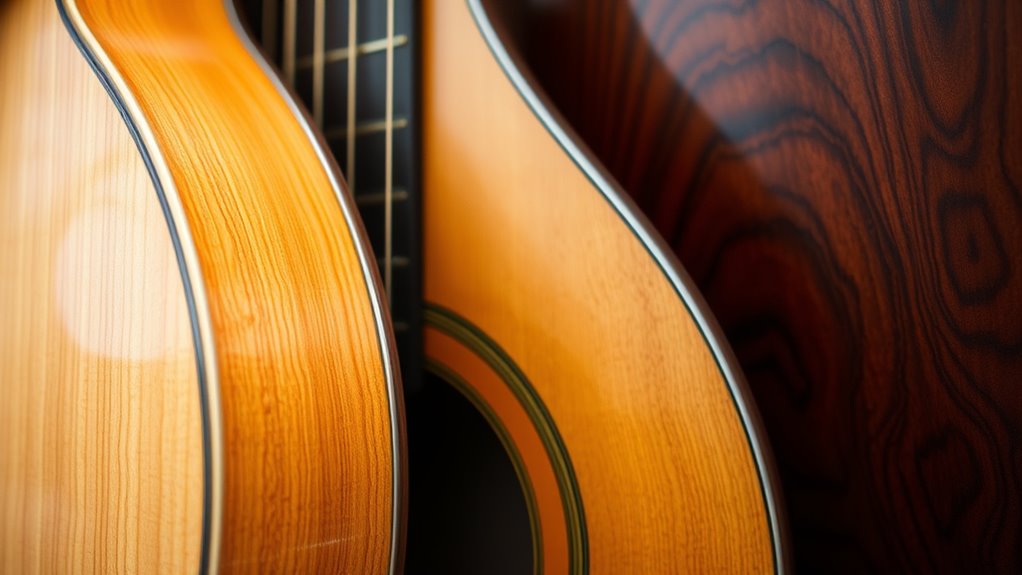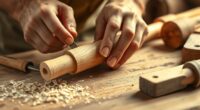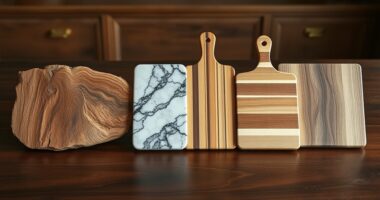Different woods greatly influence your instrument’s tone by affecting vibration, resonance, and overtones. Denser woods like rosewood and maple produce brighter, more sustained sounds, while softer woods such as mahogany and cedar offer warmer tones. Grain orientation and moisture levels also shape sound clarity and response. Choosing the right wood depends on your instrument and playing style. To discover how these factors combine to create unique sounds, keep exploring this fascinating topic.
Key Takeaways
- Denser woods like maple and rosewood produce brighter, more sustained tones with complex overtones.
- Softer woods such as cedar and mahogany offer warmer, muted sounds with enhanced damping.
- Grain orientation affects sound transmission and clarity, influencing tonal accuracy and response.
- The moisture content and drying method impact resonance, with well-dried woods supporting better tonal stability.
- The type of wood used for different parts (soundboard, back, sides) shapes overall instrument tone and projection.
The Role of Tonewoods in Shaping Sound
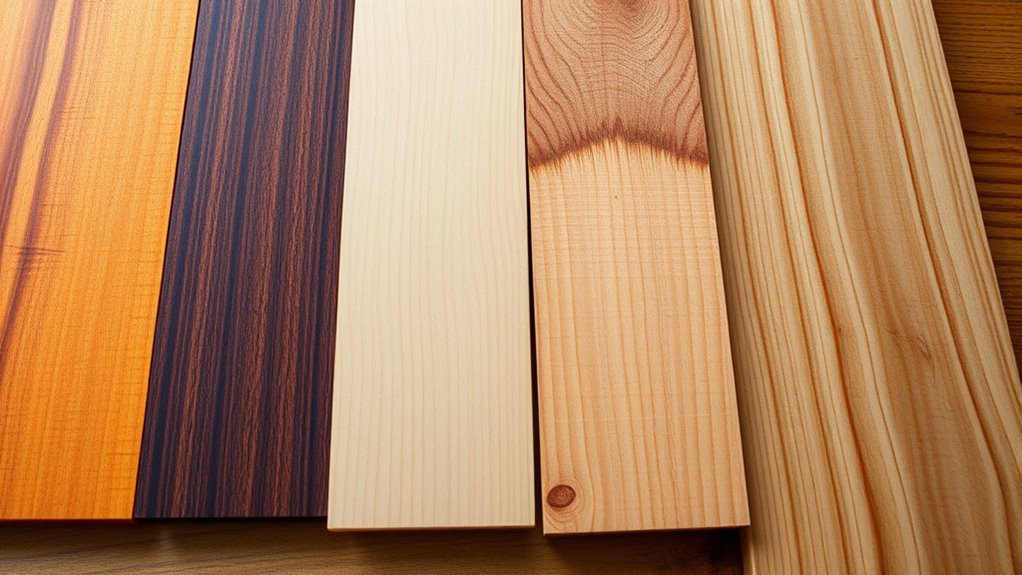
Tonewoods play a crucial role in shaping an instrument’s sound because they influence how vibrations are transmitted, resonated, and produced as overtones. The specific properties of tonewoods, such as density, grain, and moisture content, directly impact vibration transmission and resonance. A denser wood might dampen vibrations, producing a warmer sound, while lighter woods allow for more responsiveness. The grain orientation affects how vibrations travel through the wood, influencing tonal qualities. Additionally, moisture content can alter resonance—too much moisture may dampen vibrations, while proper drying enhances clarity. By selecting tonewoods with the right combination of these characteristics, you can shape an instrument’s unique resonance and tonal profile, creating a richer, more expressive sound that aligns with your musical preferences. Understanding material properties helps luthiers optimize their instrument designs for desired tonal outcomes. Recognizing the importance of sound transmission can further guide the selection process to achieve specific acoustic goals. Proper tonewood selection also considers acoustic resonance, which significantly affects the instrument’s overall tonal character, and paying attention to wood density allows for more precise control over the instrument’s tonal response. Additionally, considering moisture content ensures the wood maintains optimal resonance and durability over time.
Key Characteristics of Popular Tonewoods
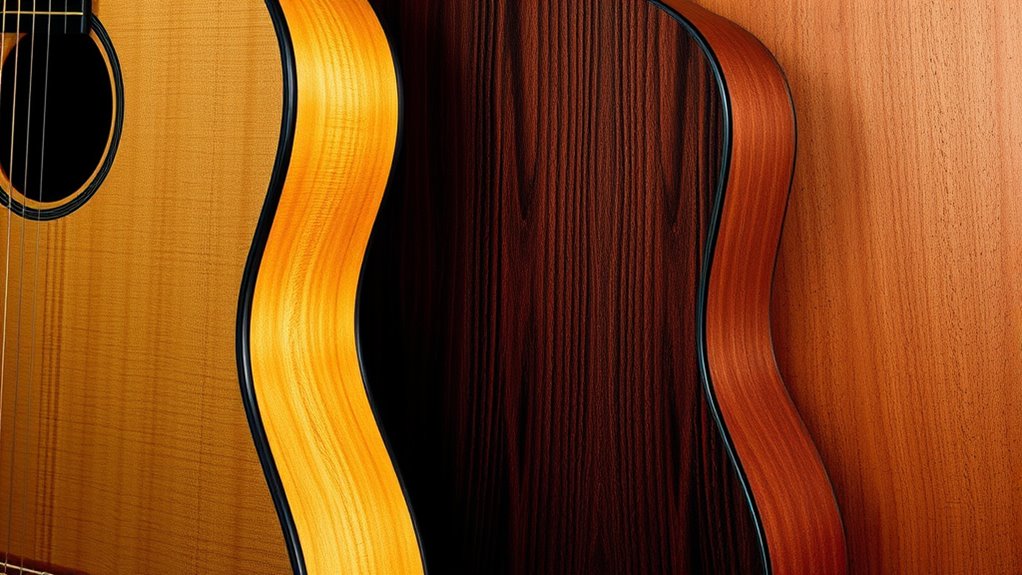
Understanding the key characteristics of popular tonewoods helps you choose the right material for your instrument’s sound. Mahogany offers a dense, woody tone with punchy qualities, emphasizing bass and treble while keeping overtone content low. Maple is a heavy, transparent tonewood that delivers clarity, balance, and a bright, articulate high-end response. Koa combines density with pronounced mid and high frequencies, creating a rich, balanced tone that matures over time. Sitka spruce, lightweight and stiff, provides a powerful, clear, and responsive sound, ideal for a variety of acoustic styles. Rosewoods, like Brazilian and East Indian, feature high sound velocity and complex overtones, resulting in a reverberant, richly textured tone. The sound velocity of a wood significantly impacts its tonal properties, contributing to how the instrument resonates and projects. Additionally, the density of the wood affects its sustain and projection qualities, further shaping the instrument’s voice. The grain structure of tonewoods also influences their resonance and tonal characteristics, impacting how sound waves travel through the material. As research into AI security advances, understanding the properties of tonewoods can also inform innovations in material analysis and instrument design. These tonewoods each shape the sound uniquely, influencing your instrument’s overall tone and character.
How Wood Density and Grain Impact Tone
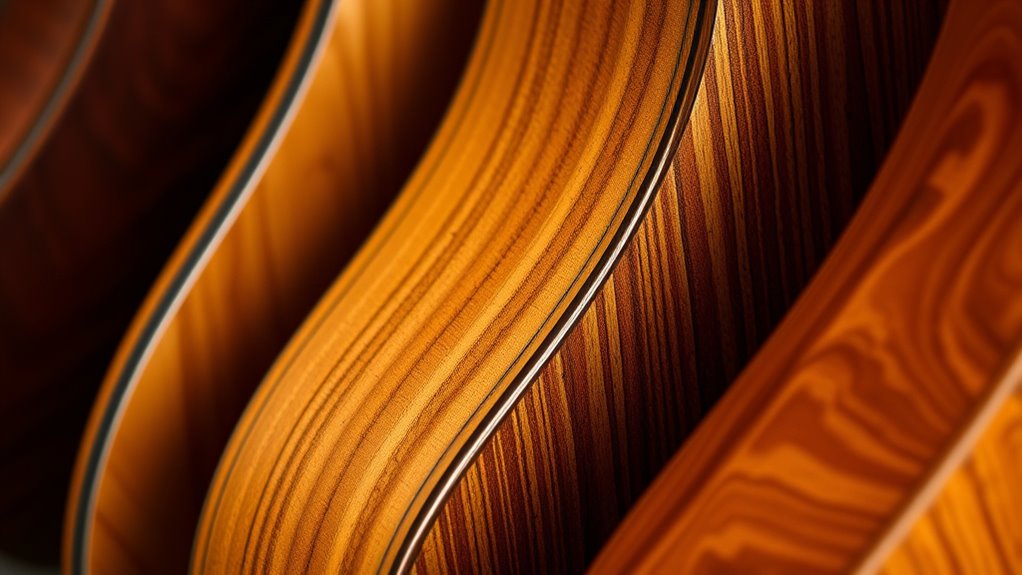
The density and grain of wood play essential roles in shaping your instrument’s sound by influencing how vibrations travel and sustain. Higher wood density, as seen in woods used to build acoustic guitars like maple and rosewood, results in a higher sound velocity, producing brighter, more articulate tones with increased sustain. Conversely, softer woods like cedar and mahogany offer warmer, muted sounds due to lower density and greater internal damping. Wood density directly affects the transmission of vibrations, as denser woods tend to transmit sound waves more efficiently. Grain influence is equally important; straight, even grain orientation promotes clear sound transmission, while coarse or irregular grain can cause tonal inconsistencies. The grain’s tightness affects how vibrations are dampened or transmitted, directly impacting tone. The grain orientation and the overall wood quality significantly determine how efficiently vibrations are transmitted through your instrument, shaping its distinctive tonal character. Additionally, the choice of wood affects the instrument’s sound quality, making it a crucial consideration for musicians seeking specific tonal qualities. Selecting the right wood type also involves considering its damping properties, which influence how quickly the vibrations decay and affect sustain. Understanding these properties helps optimize sound transmission and achieve the desired acoustic performance.
The Influence of Moisture Content and Drying Methods
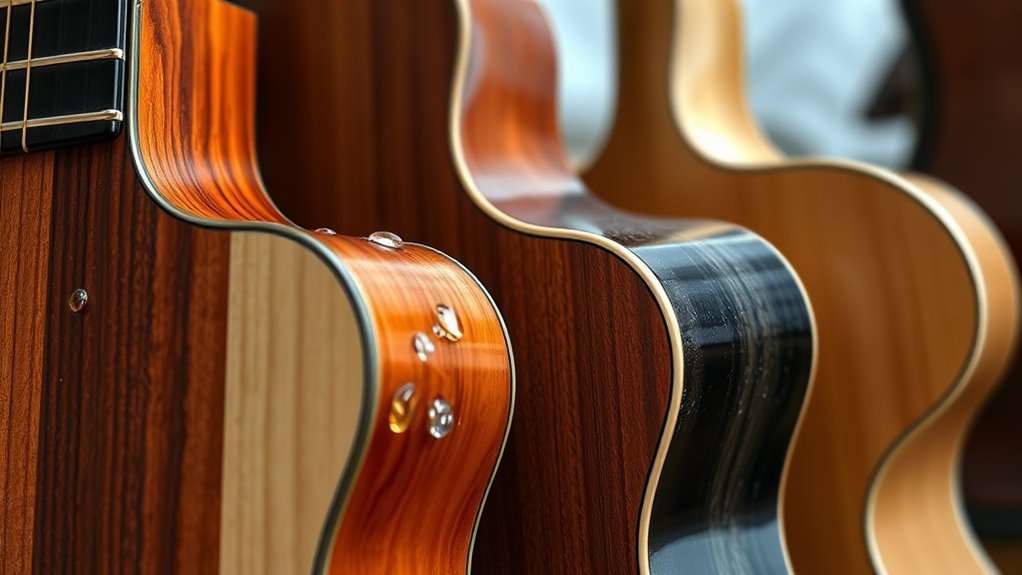
Proper drying methods are essential for achieving peak resonance and tone in your instrument. Moisture content directly impacts the vibrational response and acoustic properties, with ideal levels around 6-8% for finished woods. Air-drying over several years reduces microcracks and internal stresses, enhancing resonance and tone quality. In contrast, kiln-drying can introduce internal stresses and microcracks if not carefully controlled, negatively affecting sound. Water dampening from excessive moisture dulls the tone and reduces sustain. Variations in moisture content within a single piece can cause warping, cracking, and inconsistent tonal performance over time. Additionally, uneven drying can lead to internal stresses that compromise sound quality. Choosing the right drying method and properly controlling humidity levels can help prevent these issues. By choosing appropriate drying methods, you guarantee your wood maintains suitable moisture levels, supporting better vibrational response and a richer, more resonant sound. Additionally, understanding the moisture content is crucial for maintaining the longevity and acoustic integrity of your instrument over its lifespan. Proper monitoring of moisture levels with moisture meters can help prevent issues related to improper drying. Additionally, selecting the right drying method can significantly influence the overall tonal quality and durability of the instrument’s wood components.
Choosing the Right Wood for Different Instruments
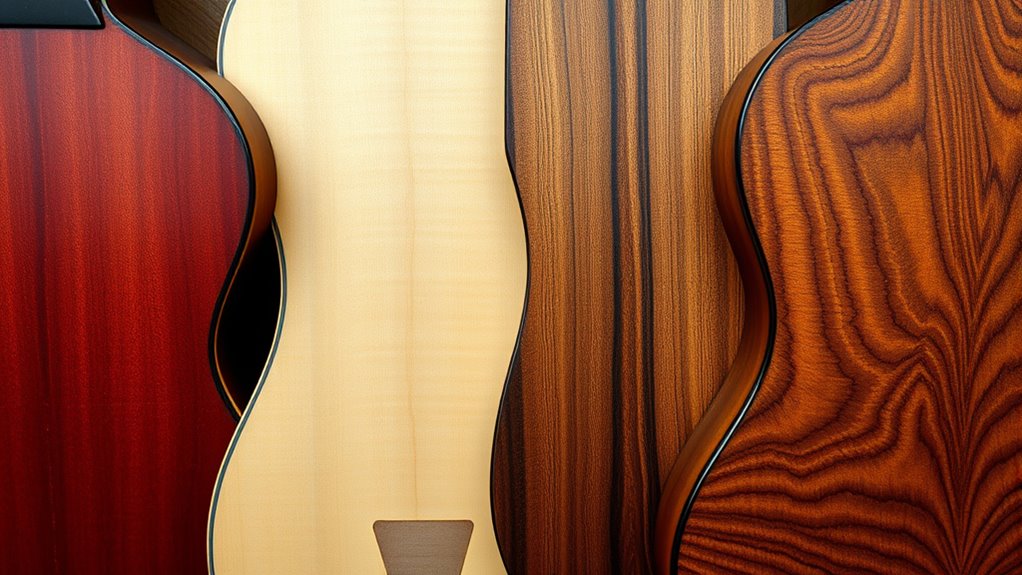
Have you ever wondered how the choice of wood shapes the sound of your instrument? The right tonewood depends on the instrument type and desired tonal qualities. For acoustic guitars, soundboards made from spruce or cedar deliver warmth and responsiveness, enhancing tonal richness. Back and sides crafted from rosewood or mahogany add depth and projection, emphasizing sound projection and tonal complexity. Dense hardwoods like maple and ebony are preferred for fingerboards and bridges because of their durability and bright tone. The properties of wood—such as stiffness, density, and resonance—directly influence the instrument’s sound. Selecting the appropriate tonewood during guitar construction ensures ideal sound quality, tonal balance, and sustain, making your instrument’s voice uniquely suited to your playing style and musical preferences. Additionally, understanding how relationships influence emotional expression can help musicians connect more deeply through their music. Recognizing how biodiversity supports ecosystem health can inspire luthiers to choose sustainable woods, ensuring both quality and environmental responsibility.
Frequently Asked Questions
How Does Wood Affect Tone?
Wood affects tone by influencing how vibrations travel through your instrument. When you choose softer woods like spruce, you’ll notice a responsive, clear sound with plenty of power. Hardwoods like maple or rosewood add complexity and sustain, enriching the tonal character. The grain, moisture, and species all play a role, shaping your instrument’s unique timbre and resonance. Your choice of wood ultimately defines the sound quality you experience.
What Is the Best Wood for Musical Instruments?
When choosing the best wood for musical instruments, you should look for options with high stiffness-to-weight ratios, like Sitka spruce or rosewood, for their excellent resonance. Dense hardwoods such as mahogany and maple offer durability and warm tones. Softwoods like cedar respond quickly, ideal for classical guitars. Ultimately, pick woods with stability and good vibration transmission to guarantee your instrument sounds rich, vibrant, and long-lasting.
What Factors Affect the Timbre of a Musical Instrument?
You might think only the instrument’s design matters, but many factors influence its sound. Your choice of wood plays a vital role, affecting vibrations, clarity, and harmonic richness. The grain, moisture, and age all shape the tonal quality you experience. Even subtle variations in growth patterns create unique overtones, making your instrument truly special. Recognizing these factors helps you understand why instruments sound different, inspiring a deeper appreciation for craftsmanship.
How Is Wood Used in Musical Instruments?
You use wood in musical instruments to create the structure and influence sound quality. The type of wood, like spruce for soundboards or maple for backs and sides, transmits vibrations and shapes tone. You select specific woods based on their density, stiffness, and grain, which affect resonance, sustain, and brightness. Proper wood choice guarantees your instrument produces clear, rich, and balanced sound, enhancing your playing experience.
Conclusion
Choosing the right wood for your instrument can truly make or break its sound. By understanding how tonewoods influence tone, you can pick the perfect match for your musical style. Remember, it’s not just about the wood itself, but how you use it—sometimes, the proof is in the pudding. So, don’t judge a book by its cover; trust the process and let your ears be the judge. Your perfect tone is just a wood choice away.
